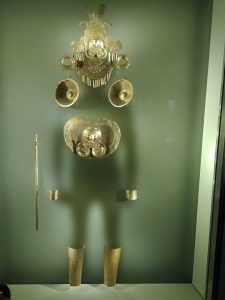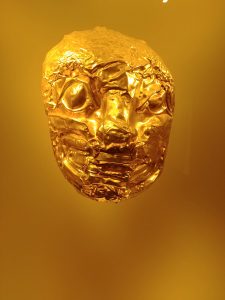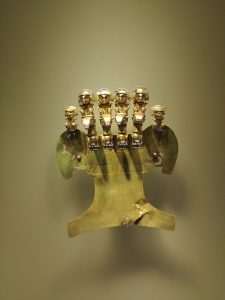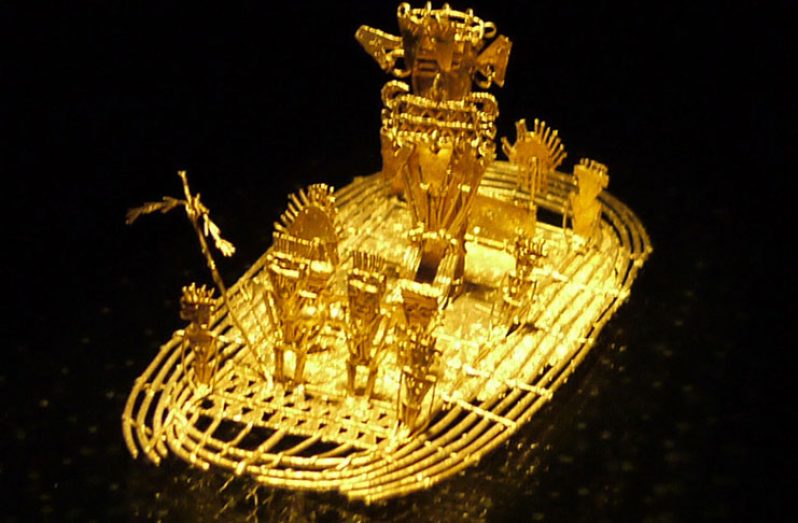–It’s a museum in Colombia!
Story and photos by Rabindra Rooplall
COLOMBIA’S Museum of Gold brings to life a treasure-seeking pirate’s wildest dreams as an almost endless array of auric objets d’art take visitors to a place back in time where gold occurred in great abundance.
The Museum of Gold (El Museo del Oro) in Bogotá, Colombia has more than 30,000 pieces of gold artifacts, and 20,000 pieces of ceramics and textiles from pre-Columbian cultures in that part of South America.

It’s also one of the most visited of the country’s tourist attractions, in that it sees some 500,000 tourists annually.
Tours are conducted in both English and Spanish. The English tour always begins at 11:00hrs and 16:00hrs, while the Spanish one is done at 10:00hrs (Saturdays only), 11:00hrs, 15:00hrs and 16:00hrs.
The museum incorporates a modern auditorium, gift shop, restaurant and café, and is rightfully ranked among the world’s best.
The power of gold lies in its propensity to attract, and The Gold Museum, with its modern infrastructure, excels at this.
On entering the Museum, one can immediately sense the magic and aura of the environment, as the feel of the mysterious cultures are enshrined in fragments of wonders.
The treasures are the remains that survived the test of time, as they comprise artifacts belonging to 13 Pre-Hispanic societies.

Those societies are the Muisca, Urabá and Chocó, Malagana, Zenú, Tairona, Tumaco, Nariño, Cauca, Calima, San Agustín, Tierradentro, Tolima and Quimbaya.
At the facility, which boasts four floors, the world’s most important collections of Pre-Colombian metalwork enhance the glow and sense of pleasure that assails one at first glance.
And while metal tends to bring the old world to the new, it is also a substance upon which most of the global economic system is based.
The mineral of historical nightmares and modern dreams also has a special room on the fourth floor, which enables visitors to be awed by the mysterious storytelling and magnificent use of sound and light to focus on various artifacts at different scenes.
The golden treasures that survived the Spanish Conquest are a combination of body decorations and armour, ornately decorated figures, armbands, breastplates, ceramics, ancient metalworks and textiles amongst other artifacts.

There are also a mixture of animals in gold such as jaguars, frogs and eagles.
The artifacts found in the spacious museum, which is organised into four exhibition galleries, depict the great metals that were used in religion and politics.
The galleries set out to achieve a close relationship between the visitor and the objects, their colours, textures and designs.
A piece titled “Muisca Raft” is one of the highlights of the museum, as, discovered in a cave near Bogotá, it may be the key to the myth of El Dorado. The Muisca Peoples were one of four advanced civilizations of the Americas (apart from the Aztecs, Mayans, and Incas), and were best known for their craftsmanship with gold.
The piece depicts a chieftain standing on a flat raft and surrounded by priests and oarsmen. The image recalls the ceremony recounted in the legend of El Dorado, in which a new chieftain would sail with important members of the community to the middle of the Guatavita Lake to leave gold offerings to an underwater-dwelling god, by tossing the precious metal into the water.

According to legend, the chieftain would also cover himself with gold dust and dive into the water. Legend also has it that Muisca people valued gold in spiritual rather than monetary terms.
I would surely advise anyone visiting Colombia to take a tour of the Gold Museum, as the memory is priceless.



.jpg)











